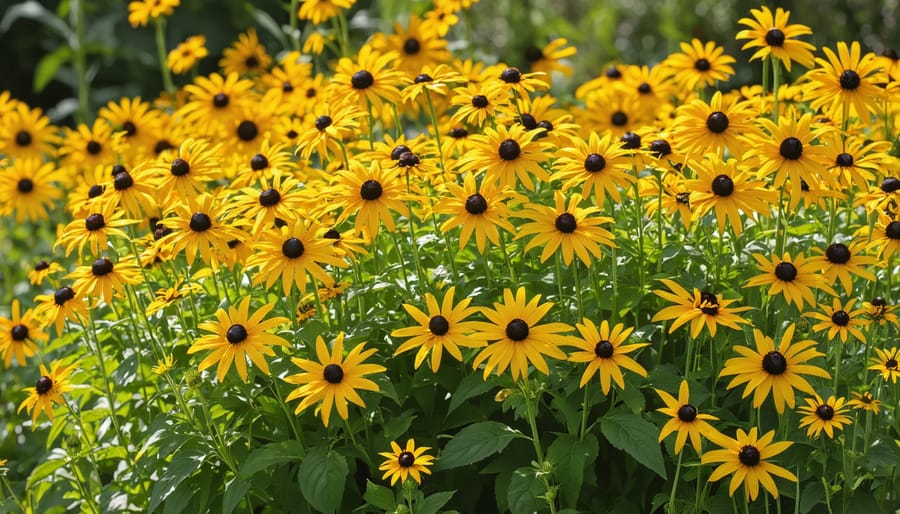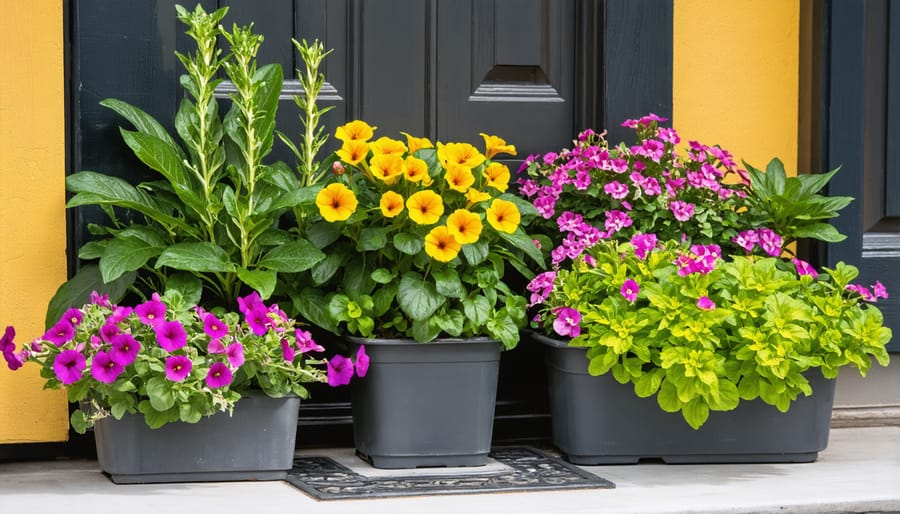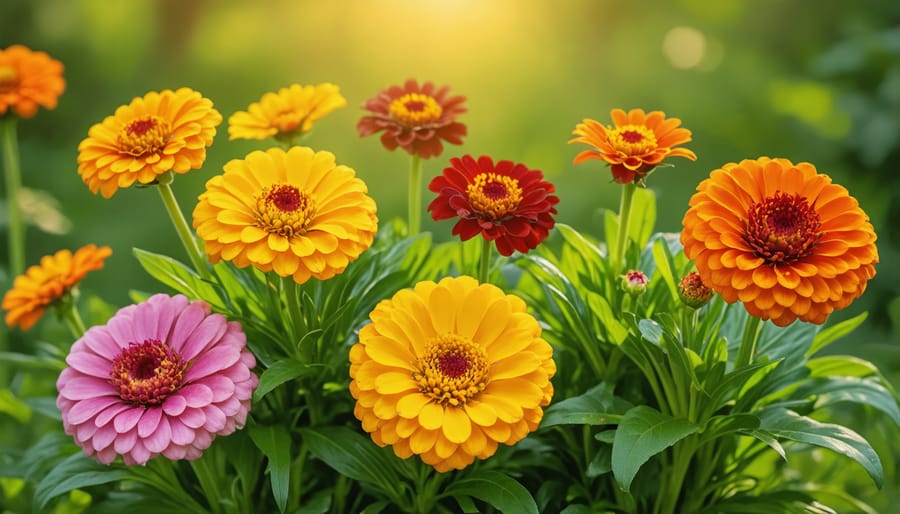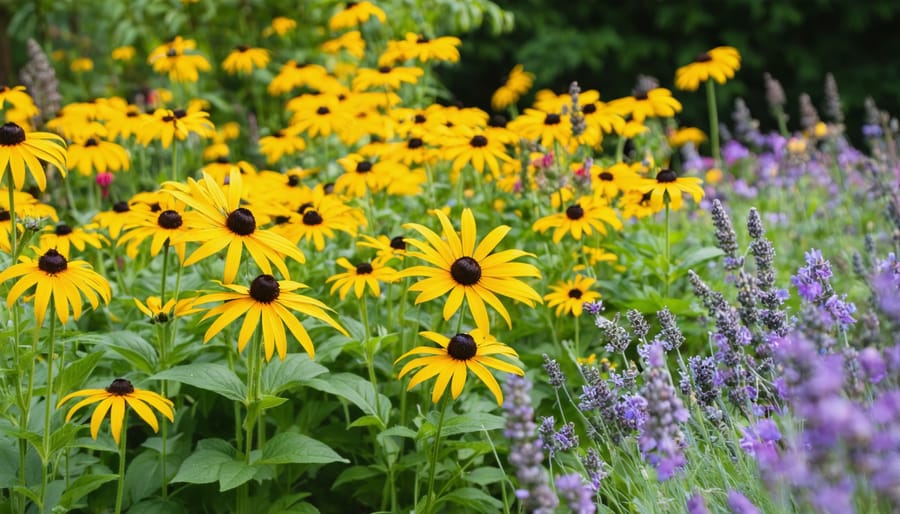Transform your garden into a season-long color display with low-maintenance perennials like Black-Eyed Susans, Lavender, and Coneflowers that bloom continuously from late spring through fall. These hardy bloomers thrive in full sun and establish deep root systems, requiring minimal intervention once planted. Strategic companion planting with long-flowering annuals such as Zinnias, Cosmos, and Verbena creates overlapping bloom cycles, ensuring your garden remains vibrant even as individual plants complete their flowering periods. Plant these summer-long performers in well-draining soil enriched with organic matter, spacing them according to mature sizes to prevent overcrowding and encourage abundant blooms. Most continuous-blooming varieties respond exceptionally well to regular deadheading—simply remove spent flowers every few days to redirect energy into new bud production, extending the blooming season by several weeks or even months.
Low-Maintenance Perennials That Bloom All Summer
Sun-Loving Perennials
For reliable summer-long color, sun-loving perennials are your garden’s best friends. Black-Eyed Susans bring cheerful yellow blooms that attract butterflies and create stunning natural bouquets. These hardy flowers start blooming in early summer and continue well into fall, requiring minimal maintenance beyond occasional deadheading.
Coneflowers, also known as Echinacea, are another summer superstar that adds both beauty and beneficial properties to your garden. Their distinctive peaked centers surrounded by drooping petals come in various colors, from classic purple to modern whites and corals. These sturdy plants thrive in hot conditions and keep producing flowers even during dry spells.
Daylilies are perhaps the most reliable of summer bloomers, earning their nickname “perfect perennial.” While individual blooms last only a day, each plant produces multiple buds that open in succession, creating weeks of continuous color. Available in countless colors and patterns, they’re practically maintenance-free once established.
All these perennials prefer full sun and well-draining soil. To encourage continuous blooming, remove spent flowers regularly and provide occasional deep watering during dry periods. These tough plants will reward your minimal effort with months of vibrant blooms, making them perfect choices for busy gardeners who want lasting summer color.
Shade-Tolerant Options
Not every garden is blessed with full sun, but that doesn’t mean you can’t enjoy beautiful blooms all summer long! For those shady spots, several stunning perennials will provide reliable color throughout the growing season.
Astilbe is a true shade garden champion, producing feathery plumes in shades of pink, red, white, and lavender. These elegant plants thrive in moist, well-draining soil and can reach heights of 1-3 feet. Their fern-like foliage adds texture to your garden even when they’re not blooming.
Hardy Geraniums, also known as Cranesbill, are perfect for partial shade and will reward you with continuous blooms from late spring through fall. These low-maintenance plants form attractive mounds of deeply cut foliage, topped with delicate flowers in purple, pink, or white. They’re excellent for groundcover and border edges.
Coral Bells (Heuchera) are prized for both their tiny bell-shaped flowers and their colorful foliage. Available in an array of leaf colors from deep purple to caramel and lime green, these versatile plants produce dainty flower spikes that attract hummingbirds. They’re drought-tolerant once established and perform beautifully in containers or garden beds.
All three options require minimal maintenance beyond occasional deadheading and dividing every few years to keep them healthy and vigorous. Just ensure the soil remains consistently moist but not waterlogged for best results.
Reliable Annual Flowers for Continuous Color
Heat-Resistant Varieties
When summer temperatures soar, you’ll want to fill your garden with heat-resistant flowers that can handle the intensity. Zinnias are absolute champions in this category, offering a brilliant display of colors from vibrant pinks to deep oranges. These sturdy blooms actually thrive in hot weather and will keep producing flowers all summer long with regular deadheading.
Marigolds are another summer superstar that laugh in the face of heat. Their cheerful yellow and orange blooms not only add a splash of sunshine to your garden but also help deter unwanted pests. Plant them in full sun, and they’ll reward you with continuous blooms right through to fall. They’re particularly great for beginner gardeners since they’re nearly impossible to kill!
Don’t overlook Petunias when planning your summer garden. These versatile bloomers come in every color imaginable and have been bred to withstand both heat and humidity. Modern varieties like the Wave series are especially resilient, spreading beautifully and requiring minimal maintenance beyond regular watering. For best results, plant them in well-draining soil and give them a light trim mid-season to encourage fresh growth and more abundant blooms.
All three of these heat-loving varieties are perfect for containers, borders, or mass plantings, giving you plenty of options for creating a colorful summer display that won’t wilt when temperatures climb.

Container-Friendly Options
For gardeners with limited space or those who love decorating patios and balconies, container-friendly flowers that bloom all summer are absolute treasures. Calibrachoa, often called Million Bells, is a delightful trailing plant that produces hundreds of tiny, petunia-like flowers in vibrant shades of pink, purple, yellow, and red. These hardy plants thrive in hanging baskets and window boxes, requiring minimal maintenance beyond regular watering and occasional deadheading.
Verbena is another excellent container choice, offering clusters of small, bright flowers that attract butterflies and hummingbirds. This versatile plant comes in both upright and trailing varieties, making it perfect for mixed container arrangements. Its flowers bloom in rich purples, pinks, and whites, creating stunning visual displays from early summer through fall.
Lantana stands out as a heat-loving container plant that truly shines during the hottest months. Its clusters of small, multicolored flowers often feature combinations of yellow, orange, red, and pink on the same plant. What makes Lantana particularly special is its color-changing blooms – individual flowers change hues as they mature, creating a kaleidoscope effect. These plants are incredibly drought-tolerant and thrive in full sun, making them perfect for sunny patios and balconies where other flowers might struggle.
All three options are self-cleaning, meaning spent blooms naturally fall off, though occasional trimming encourages fuller growth and more abundant flowering.

Maintaining Season-Long Blooms
Deadheading and Pruning Tips
To keep your flowers blooming throughout summer, mastering the art of deadheading and pruning is essential. Deadheading – the process of removing spent blooms – signals to your plants that they should produce more flowers instead of going to seed. Simply pinch or snip off faded flowers just above the nearest set of healthy leaves, using clean, sharp gardening shears.
For most summer bloomers, regular deadheading every 3-4 days encourages continuous flowering. Some plants, like petunias and geraniums, benefit from weekly pruning of leggy stems to maintain their bushy shape and promote fresh growth. When dealing with plants that produce multiple blooms on a single stem, wait until all the flowers on that stem have faded before cutting it back to the base.
Many gardeners overlook the importance of timing. The best time to deadhead is early morning or late afternoon when plants are less stressed. During particularly hot spells, combine your deadheading routine with a deep watering session to help plants recover quickly.
Some plants, like black-eyed susans and coneflowers, can be left unpruned toward the end of the season. Their seedheads provide food for birds and winter interest in your garden. However, for maximum summer blooms, keep up with regular maintenance throughout the peak growing season.
Remember to sanitize your tools between plants to prevent the spread of diseases, and always make clean cuts at a 45-degree angle to promote healing.

Watering and Fertilizing Schedules
To keep your summer flowers blooming continuously, establishing consistent watering and fertilizing routines is crucial. Most summer-blooming plants need deep watering 2-3 times per week, preferably in the early morning. Water at the base of the plants to prevent leaf diseases, and aim to keep the soil consistently moist but not waterlogged.
For fertilizing, start with healthy garden soil as your foundation, then supplement with a balanced, slow-release fertilizer in spring. During the blooming season, apply a phosphorus-rich fertilizer (like 5-10-5) every 4-6 weeks to encourage more flowers. For heavy bloomers like petunias and roses, consider using a water-soluble fertilizer every two weeks.
Remember to adjust your watering schedule based on weather conditions and rainfall. During heatwaves, you might need to water daily, while cooler periods require less frequent watering. Installing a drip irrigation system with a timer can help maintain consistent moisture levels, especially if you’re away from home.
For container plants, check soil moisture daily by inserting your finger about an inch deep – if it feels dry, it’s time to water. These plants typically need more frequent watering and fertilizing than those in the ground, sometimes requiring daily attention during peak summer heat.
Common Problems and Solutions
Even the most dedicated gardeners can encounter challenges when maintaining summer-long blooms. The good news is that most common issues have straightforward solutions. Insufficient blooming is often caused by inadequate sunlight – most summer-flowering plants need at least 6 hours of direct sun daily. If your flowers aren’t performing, consider relocating them to a sunnier spot.
Irregular watering can also disrupt blooming cycles. Establish a consistent watering schedule, and remember that deep, less frequent watering encourages stronger root systems than daily light sprinklings. Installing a drip irrigation system can help maintain optimal moisture levels.
Pest problems, particularly aphids and Japanese beetles, can quickly diminish flower production. Instead of reaching for chemical pesticides, try introducing beneficial insects like ladybugs or using a strong blast of water to remove unwanted visitors. Companion planting with marigolds or nasturtiums can naturally deter many common garden pests.
Dead or spent blooms left on plants can signal them to stop producing flowers. Regular deadheading encourages continuous blooming throughout the season. For plants like petunias and verbena, a light trim mid-season can prevent them from becoming leggy and stimulate fresh growth.
Poor soil fertility often results in fewer blooms. Apply a balanced, slow-release fertilizer at the beginning of the season, followed by monthly applications of phosphorus-rich fertilizer to promote flowering. However, be careful not to over-fertilize, as this can lead to abundant foliage but fewer flowers.
Succession Planting for Continuous Blooms
Keeping your garden vibrant throughout the summer requires a bit of planning and a technique called succession planting. Think of it as orchestrating a continuous performance where different flowers take center stage at different times. The key is to stagger your plantings every 2-3 weeks, ensuring that as one set of blooms fades, another is ready to shine.
Start by dividing your garden space into sections. Plant your first batch of quick-blooming flowers like zinnias and cosmos in early spring. Two weeks later, sow another batch in a different section. Continue this pattern throughout the growing season. This method works particularly well with annuals, which typically bloom 6-8 weeks after planting.
To make succession planting easier, create a simple calendar marking when to plant each batch. Consider combining early, mid, and late-season bloomers in each section. For example, pair spring-blooming columbines with mid-summer black-eyed Susans and late-blooming asters.
Professional gardener Maria Thompson shares her favorite tip: “I keep a small nursery area where I start new seedlings while existing plants are blooming. This way, I always have fresh plants ready to fill any gaps that appear.”
Remember to deadhead regularly and remove spent plants promptly. This not only keeps your garden tidy but also makes space for your next wave of blooms. Adding slow-release fertilizer to each new planting ensures strong growth and abundant flowers.
For best results, maintain detailed notes about which combinations work well in your garden. This information becomes invaluable for planning next year’s succession schedule, helping you create an even more spectacular continuous display.
Creating a garden that blooms throughout summer isn’t just a dream – it’s an achievable goal that can transform your outdoor space into a constant source of joy and color. By combining the various flowers we’ve discussed, from reliable marigolds and zinnias to show-stopping dahlias and lavender, you can design a garden that provides continuous blooms from late spring through early fall.
Remember that successful summer-long flowering requires a mix of early, mid, and late-season bloomers, along with proper planning and maintenance. Regular deadheading, appropriate watering, and strategic fertilizing will keep your plants healthy and productive. Don’t be afraid to experiment with different combinations and create your own unique garden style.
Whether you’re working with a sprawling backyard or a modest container garden, there’s always room for continuous-blooming flowers. Start small if you’re a beginner, perhaps with a few reliable annuals, and gradually expand your collection as you gain confidence. The reward of stepping into your garden each day to discover new blooms makes every effort worthwhile.
Take the first step today in creating your summer-long flowering paradise. Your perfect garden awaits!




